Introducing the Teochew olive vegetable, the single ingredient that will make your fried rice irresistible!
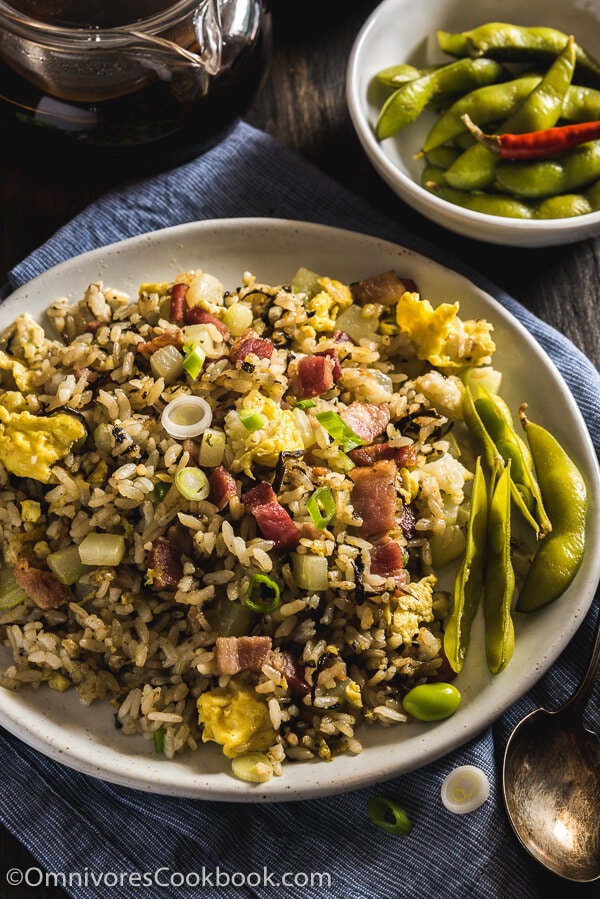
Fried rice is a staple in Chinese cuisine. It is usually fast and easy to make and will satisfy your appetite without any fuss. There are many ways to make fried rice flavorful without using too many ingredients. For example, adding hoisin sauce, kimchi, cumin powder, or soy sauce. Today I want to introduce another great ingredient, one that will stay good in your pantry forever, and spice up your meals wonderfully!
Introducing the olive vegetable
Olive fried rice is based on the main ingredient – the Chinese olive vegetable. It is not the pickled whole European olive you’re familiar with, but a paste-like mixture of mustard greens and olive fruits pickled in soy sauce and oil. It has a deeply savory and earthy taste with a hint of olive, but is smooth in texture and more complex. It is a specialty of Teochew (or chao zhou, 潮州) cuisine, a branch of Chinese cuisine, related to both Fujian and Cantonese styles, with very distinctive flavors.
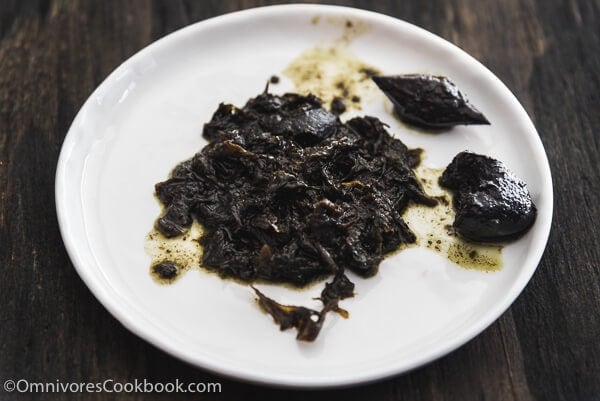
Chinese folk legend says the pickled ingredient was invented by a housewife by pure coincidence. The housewife worried that the unripe olive fruits that had been blown from a tree by a storm would be wasted. She brought them home to cook with mustard greens, just like a southern Chinese person would make pickles. The result was surprisingly delicious. And thus, the olive vegetable was invented.
However, according to historical record, the olive tree was first brought from Vietnam to Teochew before AD 900, because olive tree resin was commonly used for ship manufacture. And thus the habit of eating olives started way back.
Olive vegetables might not look very pretty. But they will make your dish shine, just like sliced olives on top of pizza.
When you’re using olive vegetables, make sure to transfer the portion you will use onto a small plate. The brand I use contains whole olives and olive pits mixed with the mustard greens. You should remove the pits and slice the whole olives into thin pieces before cooking.
Being based in Austin Texas, I failed to find the ingredient in any of the local Asian markets. But surprisingly, I found it on Amazon. Thanks to the almighty internet, I got to try out a Chinese regional delicacy that I could not even find in markets back in Beijing.

Easy and flavorful fried rice
I grew up in northern China. Eating olive vegetables is not a part of my culture. I came across this delicious pickle when a reader asked for an olive fried rice recipe. I learned how to cook olive fried rice by researching multiple websites, including recipes written by native Chinese foodies. Most recipes use ground pork, like this delicious fried rice by Noob Cook. But any protein will work in this recipe. For example, you can use ham or sausage, which skips the steps of marinating the pork, and just cook it separately.
I chose to use bacon in my recipe. Because it is extremely easy to prepare, its flavor goes well with olive vegetables, and the extra bacon grease makes the rice just perfect.
Note, this recipe requires minimal prep, but you’ll still need to get the ingredients ready and in place before turning on the heat. Like I always emphasize, stir frying requires high heat. For that reason, things will happen very quickly after you add the first ingredient into the pan. The stew-making style, chopping-as-you-cook, simply won’t cut it here. When you’re ready to cook, you should have the ingredients in the picture below near your stove.
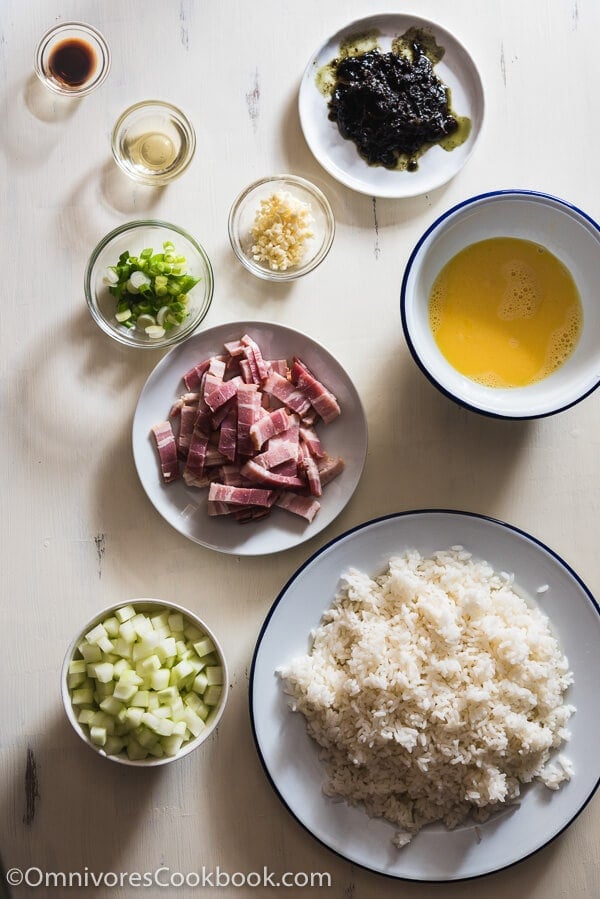
The rest is simple. Make sure your pan is hot throughout the cooking and add each ingredient one at a time. The olive vegetables are very powerful, so you can leave them to work their magic in flavoring the rice. In 10 minutes, you’ll have a plate of comforting fried rice that is way tastier than what you’d get from your local Chinese restaurant.
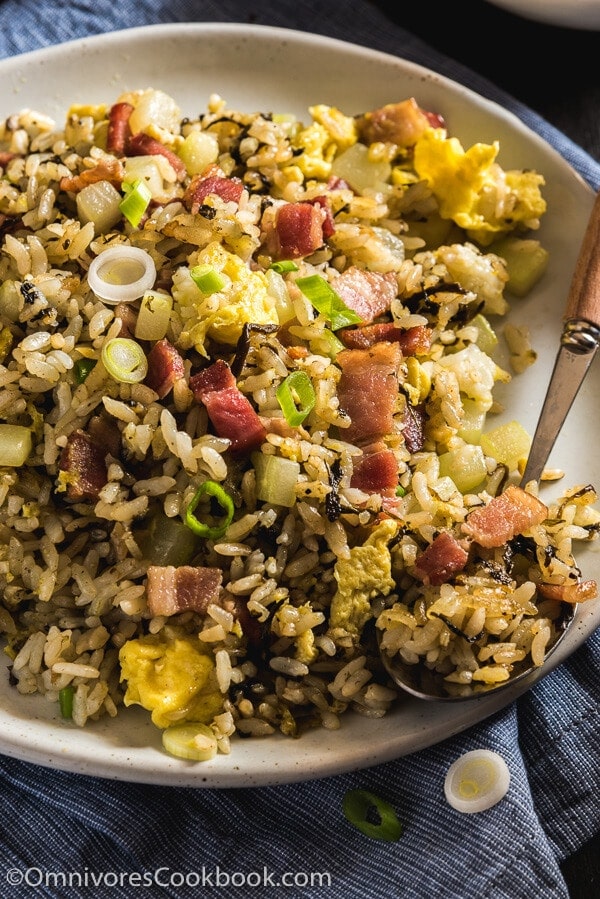
Do you like my recipes? Sign up for our weekly newsletter to get the latest updates delivered to your inbox and a FREE e-cookbook that contains my 30 most popular recipes!
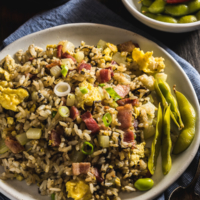
Chinese Olive Fried Rice (橄榄菜炒饭)
Ingredients
- 3 slices bacon , chopped (*see footnote 1)
- 2 garlic cloves , minced
- 2 heaping tablespoons Chinese olive vegetables (*see footnote 2)
- 1 teaspoon vegetable oil
- 4 cups cold steamed rice
- 1 teaspoon soy sauce (or light soy sauce)
- 2 large eggs , beaten
- 1 small cucumber , cubed (generates about 1 cup)
- 2 green onions , chopped
Instructions
- Add bacon to a large nonstick pan and turn to medium heat or medium high heat (*see footnote 3). Stir and cook until golden and the fat is rendered.
- (Optional) If the bacon you use is too fatty, you might get a lot of rendered fat. Remove some of the fat by dipping a paper towel into the pan with a pair of tongs. I personally like to leave a bit of bacon fat in the pan, which will make the rice extra flavorful.
- Add garlic. Stir a few times until fragrant.
- Add olive vegetables. Cook and stir until you can hear a vibrant sizzling. It might only take a few seconds if the pan is properly heated. Olive vegetables contain oil, so your pan should be greased and ready for the rest of the cooking. If you removed too much bacon fat earlier, you might want to add a small spoon of oil here, so the rice won’t dry out.
- Add rice. Cook and chop the rice with a spatula until separated into grains and heated through. Swirl in soy sauce and stir to mix well. You should again hear vibrant sizzling, throughout the cooking, without burning the ingredients. Adjust heat accordingly and remove the pan from the stove if it’s getting too hot.
- Move everything to one side of the pan. Add cucumber. Cook and stir for a few seconds to heat them.
- Mix cucumber with the other ingredients, and move everything to one side of the pan.
- Add vegetable oil and beaten egg to the other side of the pan. Wait until the bottom sets. Stir everything together. Carefully taste the rice. The cucumber should be cooked through and the rice slightly crisped. Add green onion, stir to mix well.
- Serve warm.
Notes
- Try to select bacon that is on the lean side. If you use very fatty bacon, you might need to remove some rendered fat, so the rice won’t become too greasy.
- It is quite difficult to measure olive vegetables accurately because the threads tend to tangle together. Do not use more than two tablespoons. Otherwise your rice will be extremely salty.
- Note, you should not heat an empty nonstick pan. I use the method here to render bacon fat with low heat at first. Once the fat is rendered, the pan will be hot enough to continue cooking the fried rice. I recommend using medium heat (or medium heat on the lower end) for this recipe, because the olive vegetables and soy sauce will help caramelize the rice faster. Using high heat might burn the rice.













Hi Maggie! I really enjoyed reading about these ‘olive vegetables’ which I’ve never heard of before.
With olives being so salty, though, I’m not that surprised that olives are used in Chinese cooking as well as Mediterranean! I absolutely love olives, and would love to see what this tastes like!
Thanks for another fascinating post and delicious recipe!
Hi Maggie, I am absolutely perplexed by “olive vegetable.” I live in southern Spain and olives are the milk of human kind here. But there are certainly no olive vegetable around. I am surprised to hear you have olive trees in China? How come I’ve never had a Chinese dish including olives then? PS: I read your “about” and you’re fortunate to have your husband who proof reads for you. Bless him. He’s doing a good job BUT he’s not a cook/ food expert? Would love to have an explanation. Thanks!
Yes we have olive trees in southern part of China (I heard they’re originally from Vietnam). The olive vegetable is not pure olives. It is a combination of mustard green and olives, fermented in soy sauce and oil, until it becomes a pickle. It is used in Teochew cuisine (a bit similar to Cantonese cuisine but they use many of the regional ingredients.) I believe even a lot of Chinese people never had this pickle if they’re not local Teochew people. So I won’t be surprised that oversea Chinese restaurants never serve it. Me too, I was surprised to learn that Chinese cooking uses olives too.
My husband is a big foodie like me, but none of use is food expert. But we try our best to learn and share 🙂
Thank you for the recipe. The Olive Vegetable indeed make the rice tastier.
As I don’t eat white rice, I use brown rice instead and I thought it taste very nice.
May I know what other dishes are suitable for using Olive Vegetable?
Hi Paul, I’m happy to hear you like this recipe! We cook with brown rice most of the time too, and it always work very well in fried rice. You’ve made a great choice!
To use olive vegetable in other dishes, the things that come to the top of my head are fried noodles (similar idea as fried rice), or use it as toppings. You can also use it in simple stir fries to boost flavor, such as this recipe: https://omnivorescookbook.com/stir-fried-green-beans (at the olive vegetables when you cook the ground pork, and season with less salt).
Thanks for sharing!